Solo Trekking in India: Experiences, Challenges, and Safety Tips
Solo trekking is the best activity for first-time and experienced trekkers to forge a deep connection with nature and for self-discovery. The main reason for individuals to trek in the Himalayan region of India is to get mesmerized by the landscape, whether it be snow-covered peaks, lush green valleys, or ancient trails. Solo trekkers get to experience the adventure and challenge themselves for physical agility. Along with immersing yourself in the diverse culture, solo trekking comes with some challenges for which you must consider some safety measures. Unlike other forms of trekking, solo trekking allows for an unmatched sense of independence. Choose which trails to follow and when to take those much-needed breaks, all at your convenience. This level of freedom allows you to customize your experience to your liking. Free from the distractions or demands of a group, you can connect deeply with your surroundings. Being alone can give you a sense of introspection, enhancing your connection to nature. In this article, you will learn about the experiences, challenges, and safety tips for solo trekkers in India.
1. Solo Trekking in Different Regions
India has several different trekking destinations, each with unique rewards and challenges.
- The Himalayas: Take challenging hikes to spectacular mountain vistas on famous treks like the Annapurna Circuit or Everest Base Camp. Be ready for potentially severe weather and high heights.
- Western Ghats: Discover the Western Ghats’ lush highlands, gushing waterfalls, and varied fauna. Select from various hikes appropriate for beginner and experienced trekkers, with varied degrees of difficulty.
- Ladakh: Travel across the high-altitude desert vistas of Ladakh and see isolated villages and historic monasteries. Prepare yourself for inclement weather and altitude adjustments.
2. A Trekker must consider a few things before beginning their journey
- Distance and Duration of Trek – If you are a first-time solo trekker, you must plan a place nearby for a short duration, like 2 or 3 days. But suppose you are an experienced trekker and have prior trekking experience. In that case, experience you can customize the trek according to your desire.
- Fitness is Important – As a solo trekker, I know having a certain fitness level is essential. Because you will be walking longer distances and on unfamiliar terrain, you will also be setting up camp, cooking your food, and doing other activities for which you require physical fitness.
- Get a Basic understanding of Health and First Aid. You must have basic knowledge of basic first aid and essential life savings, along with understanding what medicine you might need. At the same time, on the trek, there would be a change in altitude, for which you must be fully aware of altitude sickness and its different forms, like Acute Mountains Sickness, HAPE, and HACE.
- Right Trekking Gear—Whether solo or group trekking, having the right gear is essential. While trekking in groups, the trekker can seek the help of a trekking company like Trekup India. But while trekking solo, they need to search for everything by themselves, like backpacks, boots, food items, and stoves.
3. Experiences to Remember
A treasure trove of trekking routes awaits solo adventurers in India, each promising a unique reward:
- Being one with nature – Let yourself get lost in the serenity of mountains, gushing streams, rustling leaves, and birds chirping. Whether it is the lush green mountains of the western ghats or the rugged terrain of the Himalayas in the north, immerse yourself entirely in nature. The beautiful hues of sunrise paint the sky, while starlit nights offer peace and tranquillity.
- Cultural Encounters – Forge meaningful connections with local villagers while striking up conversations. India offers a diverse range of cultures, even in the remote areas of the mountain region. This is the perfect way to experience local communities, their customs, and their traditions, making your experience worthwhile by enriching it with cultural insights.
- Personal Growth builds resilience and fosters a sense of accomplishment to push yourself physically and mentally on a trail. It boosts your self-confidence, pushes your limits, and develops your ability to depend on yourself. Your inner strength is exhibited through every summit conquered and every obstacle overcome.
- Serenity and Solitude – Trekking alone offers a sense of serenity unlike anything else. As you walk through the mountains, your footsteps only interrupt you, allowing you to engage in introspection and deepen your relationship with nature.
4. Challenges
It is essential to plan and prepare carefully for solo trekking to overcome its unique challenges:
- Navigation—Navigating without a guide can be strict when unfamiliar with the terrain. To stay on track, you must have a detailed map, a GPS device, and basic navigation skills.
- Mental Toughness—During difficult times, loneliness and self-doubt can surface. Maintain an optimistic attitude, travel light but wisely, and remember why you started this journey.
- Logistics—Arranging supplies, lodging, transportation, and permissions in remote areas with little infrastructure might be complex.
- Unexpected Obstacles – Prepare for erratic weather, abrupt terrain changes, or mild illnesses. Carry a first aid kit, wear clothes suitable for the weather, and prepare a backup plan if something unexpected happens.
5. Safety Measures

Trekkers must be aware of their physical condition and adopt appropriate safety measures.
- Plan Meticulously—Do extensive research on the selected route, considering distance, weather patterns, level of difficulty, and accessibility to medical services. Select a path that is marked and has easy access to information.
- Inform Others—Always give a reliable person advance notice of your itinerary, including the route you want to take and when you expect to return. Try to get in touch with them frequently.
- Gear Up Wisely—Always carry a first aid kit, enough food and water, navigational aids, adequate clothing, and an emergency shelter. While keeping your backpack light, ensure you have everything you’ll need in case of eventualities.
- Stay Alert—Always be aware of your surroundings. Look for indications of wildlife, shifting weather patterns, or altitude sickness. Avoid dangerous circumstances and follow your intuition.
- Listen to Your Body—Awareness of your physical limitations is essential when solo trekking. Never exert yourself past the point of fatigue. As needed, take breaks, drink enough water, and put your safety back before getting somewhere.
- Emergency Preparedness – Establish a plan for handling emergencies. Keep your satellite phone charged, keep emergency numbers on hand, and be prepared to signal for assistance when needed.
India’s solo trekking routes provide experiences of a lifetime among breathtaking natural settings and a multitude of cultural traditions. Although it has its share of difficulties, it can be a very fulfilling experience if planned for, prepared for, and followed safety precautions. Thus, prepare for a once-in-a-lifetime adventure as you pack your bags, put on your boots, and take small steps toward discovering the wild beauty of India’s mountains.
Share this article
Want To Trek Like Pro?
Check out the following videos if you want to trek like a pro trekker and improve your skills. These videos contain helpful tips, tricks, and techniques to help you trek like a pro. Whether you’re a beginner or an experienced trekker, these videos can provide valuable insights to enhance your trekking experience. So, watch the videos below by Trekup India experts to take your trekking skills to the next level.







Know Everything About Acute Mountain Sickness
Acute Mountain Sickness is a medical condition that can occur when individuals travel to high altitudes, typically above 8,000 feet. It is caused by the decrease in air pressure and oxygen levels in the air as altitude increases. Symptoms of Acute Mountain Sickness may include headache, nausea, vomiting, dizziness, and difficulty sleeping. To avoid Acute Mountain Sickness, it is important to gradually adjust to high altitudes and seek medical attention if symptoms worsen. To learn more about this condition, check out the videos by Trekup India.









